These delicious, rich, tasty homemade condensed milk rusks are really easy to make. The perfect rusk to dunk in coffee or tea!
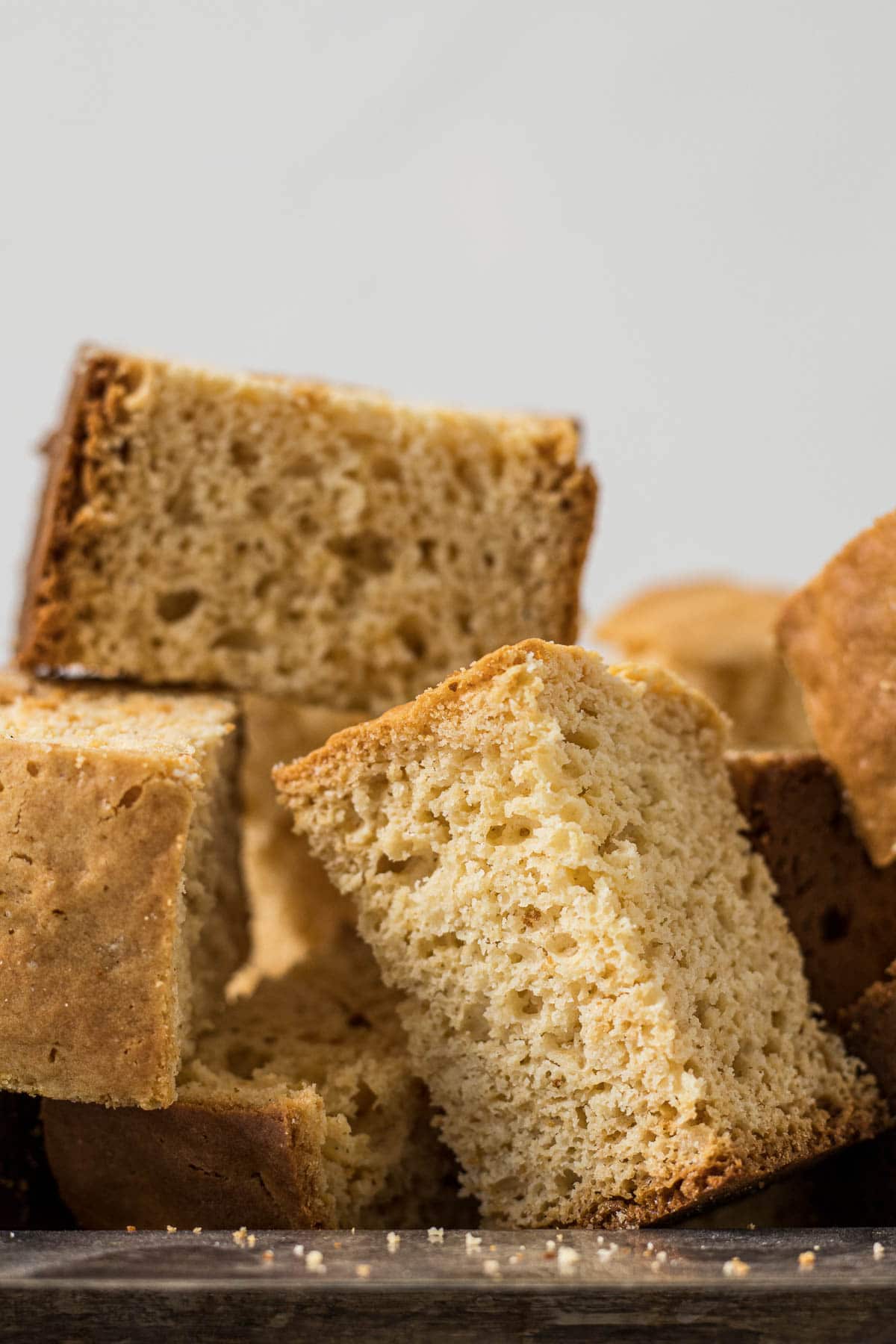
Jump to:
What are condensed milk rusks and where do they come from?
A rusk is a twice-baked biscuit that can be made from bread, bread dough, cake or quick-type doughs such as this recipe or my buttermilk rusk recipe. Once the bread, cake or rusk dough has been baked it is then torn apart or cut into slices and baked again until completely dry.
Rusks and different varieties can be found across the globe. One of the more popular commercial flavours available is buttermilk and condensed milk rusks.
These particular rusks are flavoured with condensed milk, which gives them a sweeter milkier flavour than my buttermilk rusks.
South African Rusks
Rusks have been found in South Africa since the 1690s. They were originally made by baking and then drying out bread to preserve and extend its life by removing all residual moisture.
Over the last few centuries, a variety of rusk recipes has emerged. Some recipes call for yeast or sourdough starter while others (such as this recipe) use self-raising flour or baking soda and baking powder.
Rusks are also sold across the country, either as the more commercially made versions or homemade-style. The most famous commercially made rusks are Ouma rusks.
Why is this particular recipe only a "half-batch" of rusks?
The idea for a condensed milk rusk recipe has been rattling around my head since I started Salty Ginger. Honestly, they may be my favourite flavour/variety of rusks. I wanted a recipe that used a full tin of condensed milk, was sweet but not too sweet and had a condensed milk flavour!
Because I feel that my buttermilk rusk recipe is perfect (in my opinion), I decided to use this recipe as my base recipe. Then I investigated the ingredient list for Ouma's Condensed Milk Rusks and was disappointed that these rusks seem to contain no condensed milk, just flavourings.
So I hopped over to Woolworths SA and checked out that ingredient list, which contained at least 6% of condensed milk but also contained flavourings.
After testing a few batches, it became pretty apparent to me that in order to tick all my boxes, the ideal ratio of condensed milk to flour was 1 tin to 500 grams, which is a half-batch of rusks when compared to my buttermilk rusks.
But, remember, my recipe cards allow you to scale up the recipe to 2x if you feel the need to bake more than 25 (more or less) rusks at once!
Ingredients
Here are some notes on the ingredients used in this recipe. Please see the recipe card for quantities.
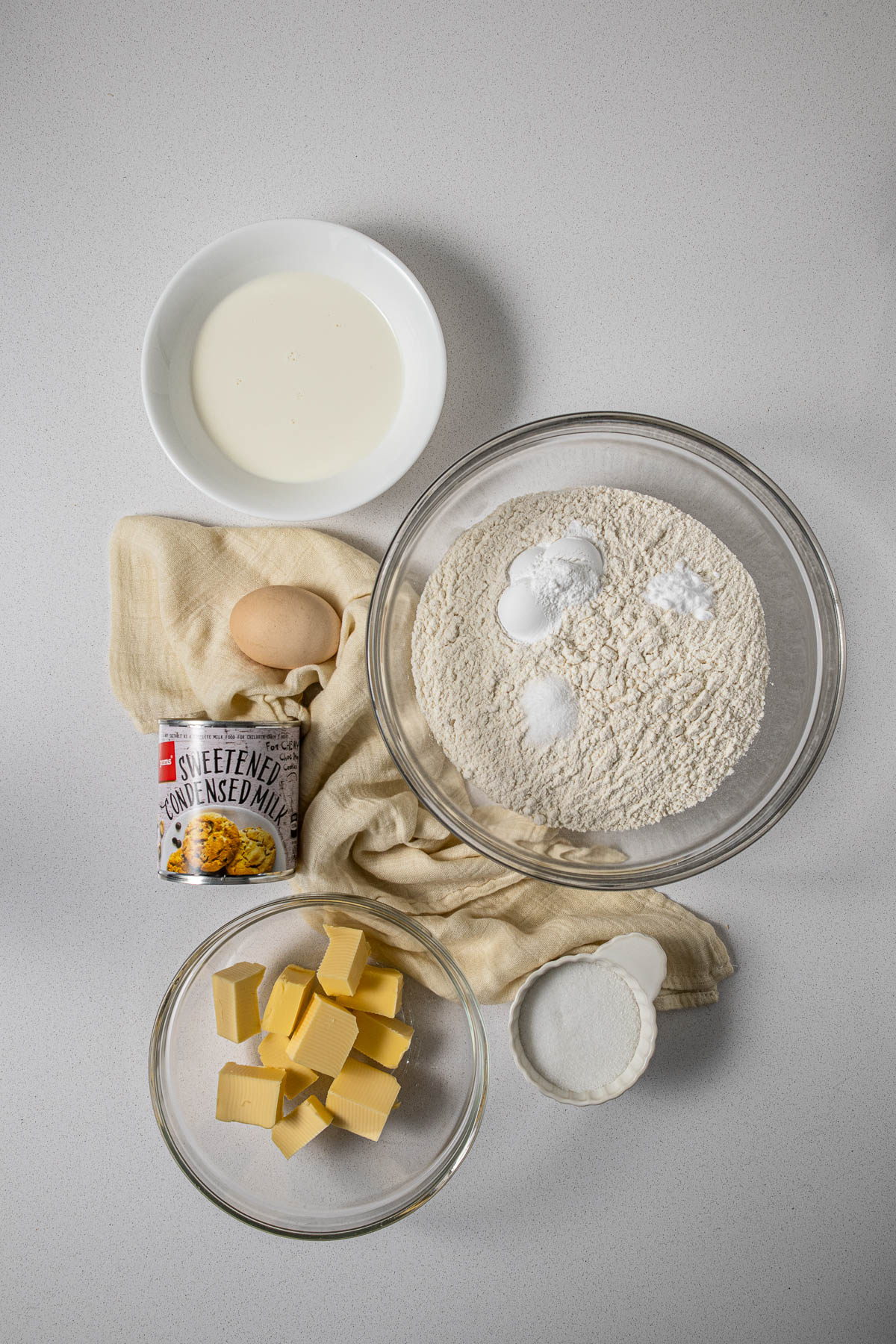
- Flour - most buttermilk rusk recipes call for self-raising/self-rising flour. This is basically plain, standard grade or cake flour (South Africa) that already contains baking powder. These rusks can be made with self-raising flour or plain flour. See the notes below.
- Salt is a crucial ingredient in all baked goods. I use table salt in all my recipes. One teaspoon of table salt equals 1.5 teaspoons of Morton Kosher Salt equals 2 teaspoons of Diamond Crystal.
- Baking soda (bicarbonate of soda or bread soda) is added to the flour to give a bit more lift because we do knead this dough a little bit. Baking soda reacts with the acidity of the condensed milk.
- An egg helps bind everything together.
- Butter adds to the depth of flavour. You can substitute butter with a vegan baking alternative if you so wish.
- Sweetened condensed milk gives these rusks both sweetness and that delicious condensed milk flavour.
- Sugar to add a little sweetness.
- Milk to add a bit of richness and moisture.
Test the freshness of your baking powder or baking soda (bicarbonate of soda or bread soda) by placing a small amount in some boiling water. If it bubbles and fizzes, it's good to use!
Salt is a crucial ingredient in all baked goods. I use table salt in all my recipes. One teaspoon of table salt equals 1.5 teaspoons of Morton Kosher Salt equals 2 teaspoons of Diamond Crystal.
Making Condensed Milk Rusks without self-raising/self-rising flour
To make condensed milk rusks without self-raising/self-rising flour, simply add 3.5 level teaspoons of baking powder to the flour.
Room Temperature Ingredients
Use room temperature ingredients! Using room temperature ingredients ensures that ingredients in the batter or dough will incorporate easier. Take note that room temperature refers to around 20°C/68F.
- To bring eggs to room temperature quickly, place them into warm water for about 10 to 15 minutes.
- To bring butter to room temperature quickly, cut the butter into cubes and zap in the microwave at 20% power in 10-second intervals. Or place the cubes in a bowl over warm water (such as with a double boiler) over low heat for 1 minute!
- Milk, buttermilk, and cream can be brought to room temperature by zapping in the microwave at 20% power in 10-second intervals. Or on a low heat for a minute or two swirling every 10-15 seconds.
Weighing & Measuring Ingredients
Weighing ingredients with a kitchen scale is more accurate than using measuring cups. All my recipes are developed and tested using grams only.
However, I have activated the metric-to-cup conversions. Simply click on "cups" or "metric" for your preferred measurements. For these conversions, cups are equal to 240 millilitres/8 fluid ounces, tablespoons are 15 milliliters and teaspoons are 5mL.
Making Condensed Milk Rusks
Step 1 - Preheat the oven to 200°C/390F, or 180°C fan. Grease and line a 9"x9" (23cmx23cm) square tin.
Step 2 - Weigh out the flour, and add in the salt and baking soda. Whisk through to remove any lumps and distribute the ingredients through the flour.
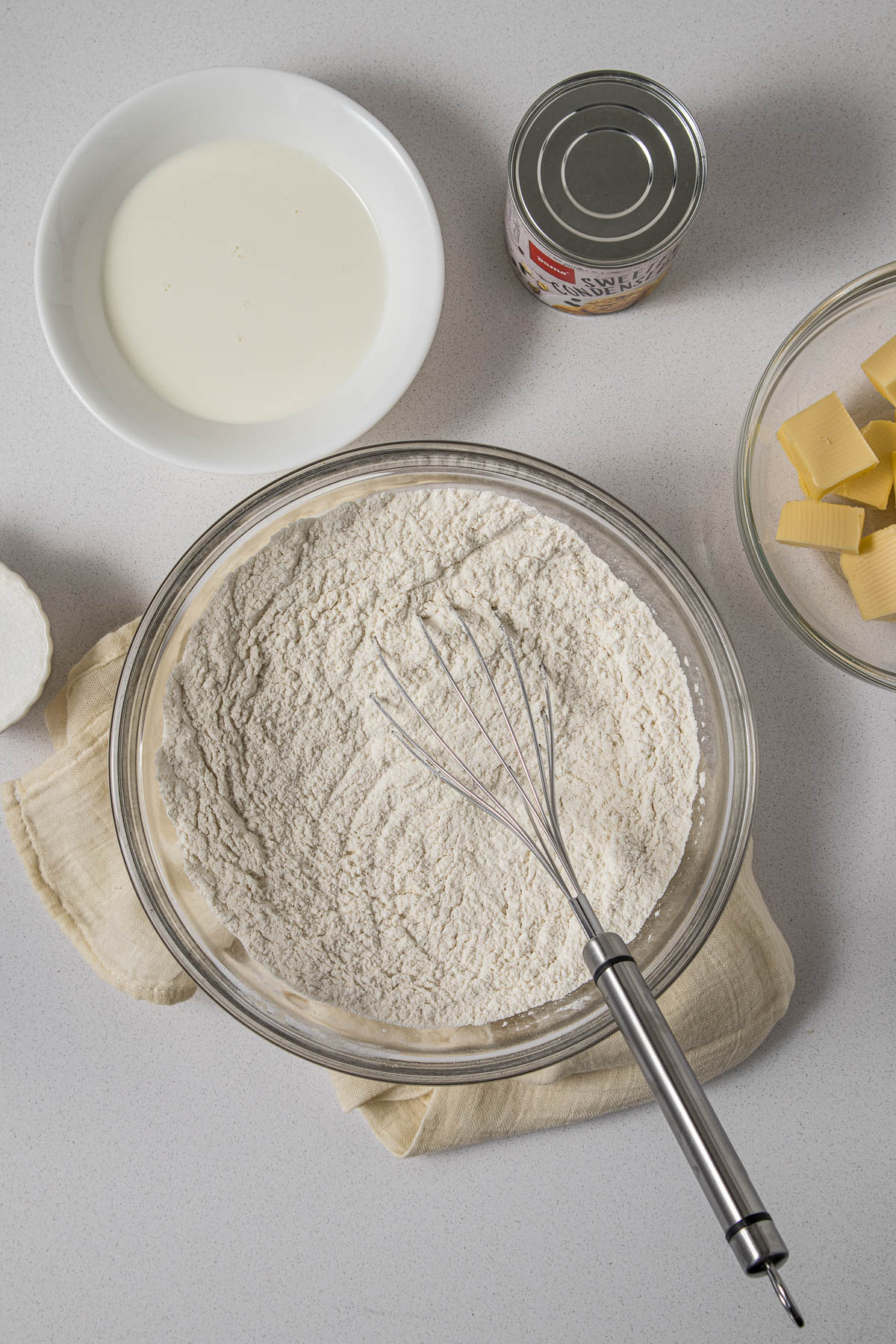
Step 3 - Melt the butter, then add in the sugar and whisk through until completely dissolved. The sugar may need to be heated with the butter to completely dissolve.
Step 4 - Whisk together the egg and milk. Add the milk, butter, and sweetened condensed milk to the flour. Mix with a wooden spoon until a soft dough has formed. Knead the dough a few times in the bowl, or really mix a few times after all the ingredients are combined with the wooden spoon to allow for some gluten formation.
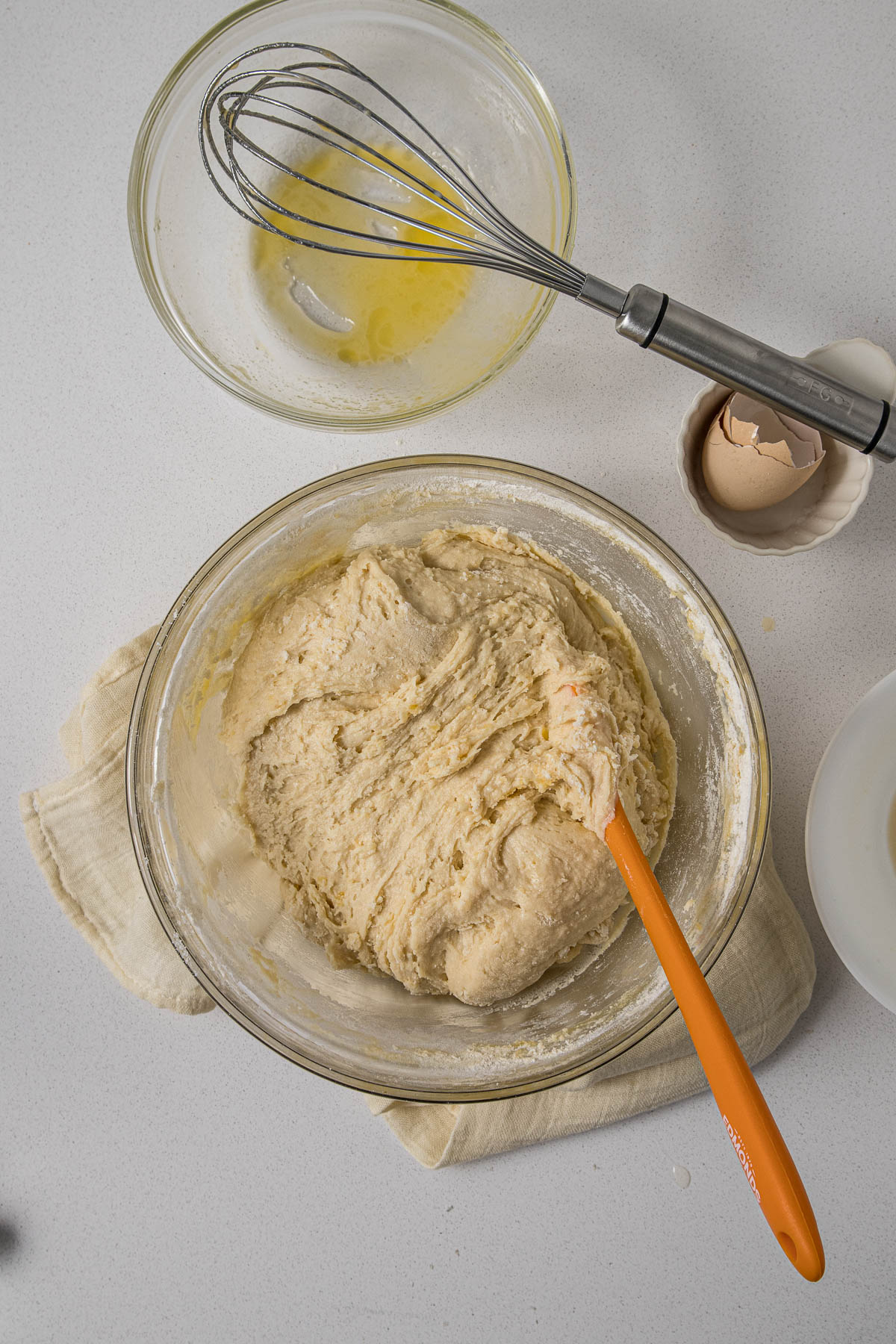
Step 5 - Press the dough into the prepared baking dish.
TIP - placing a bit of oil on your hands will stop the dough from sticking.
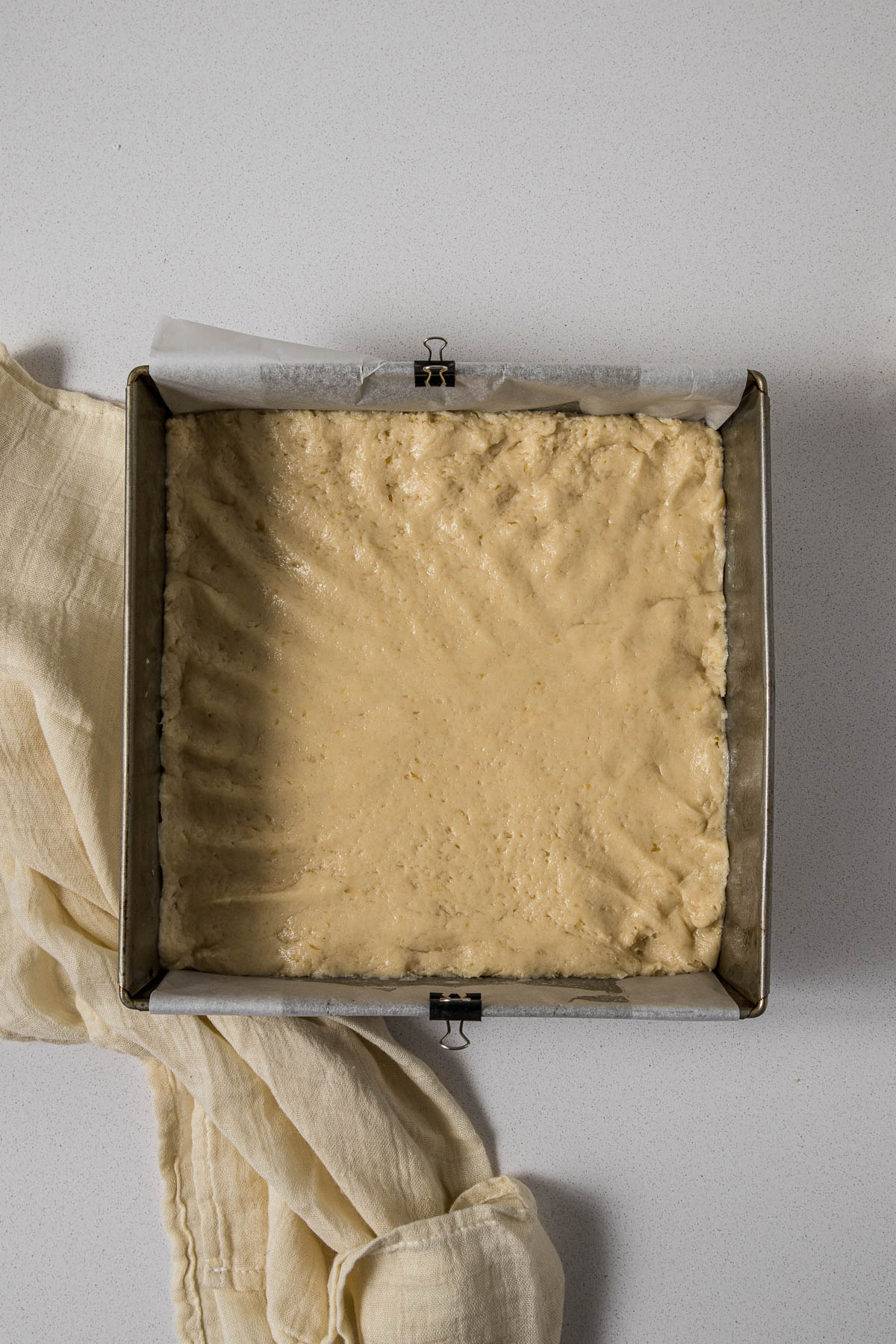
Step 6 - Bake the rusks for 45 to 60 minutes or until a cake tester comes out clean from the center of the rusks. The rusks will have doubled in size during the baking process.
TIP - if the rusks are browning too quickly in the oven when checking them at the halfway mark, cover them with foil for the rest of the bake.
Step 7 - Allow the rusk to cool for 10-15 minutes before turning it out onto a wire cooling rack to cool completely. Once completely cooled, slice the rusks using a serrated knife. Place the rusks on a baking sheet, in a single layer, and set your oven to a maximum of 110°C/230F (cool oven), preferably with the fan on to dry the rusks out. This process can take anywhere from 3 to 6 hours, usually dependent on the thickness of your rusks.
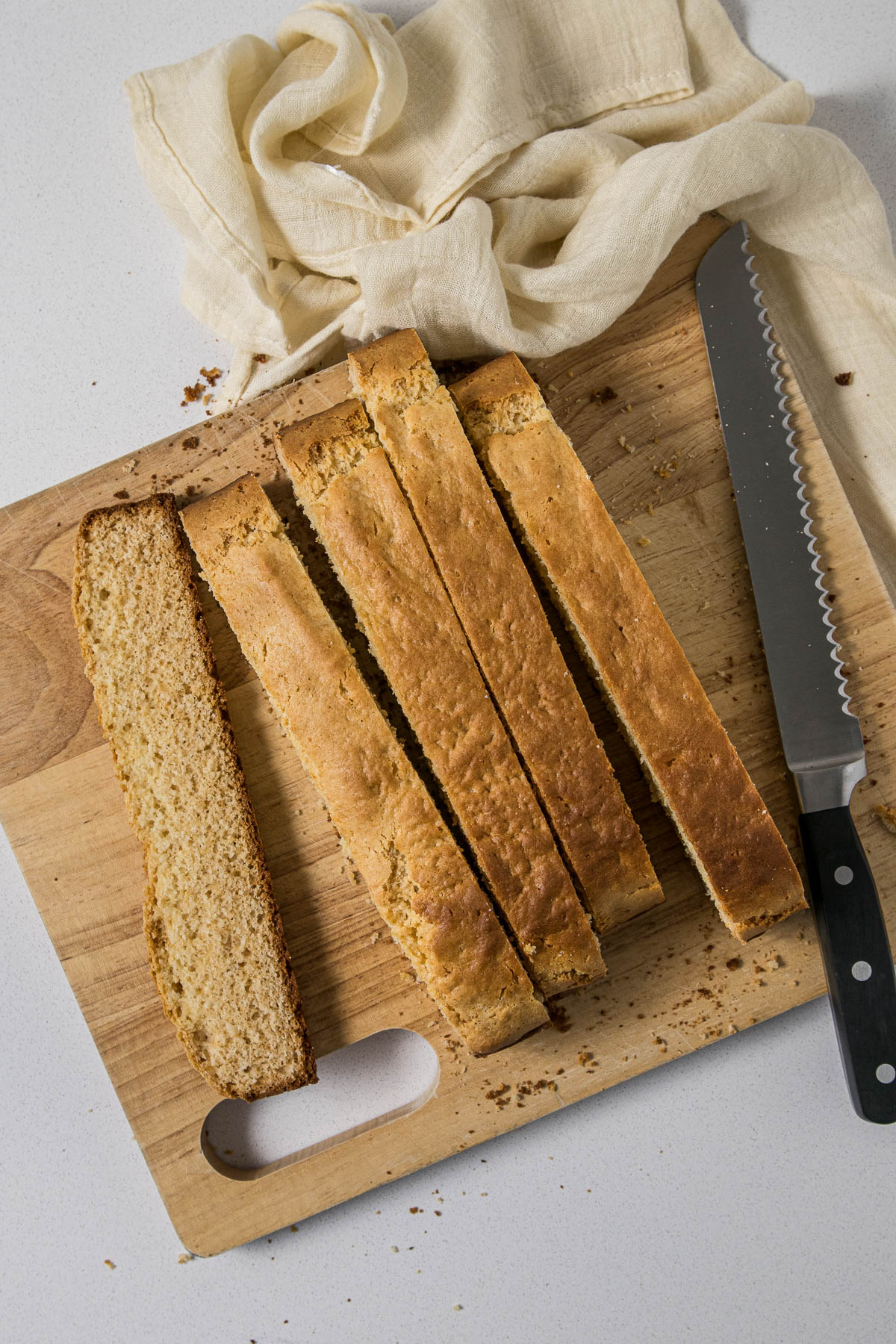
Step 8 - When the rusks are dry, store them in an airtight container, at room temperature, for up to a month. Serve with a hot cup of tea or coffee for dunking.
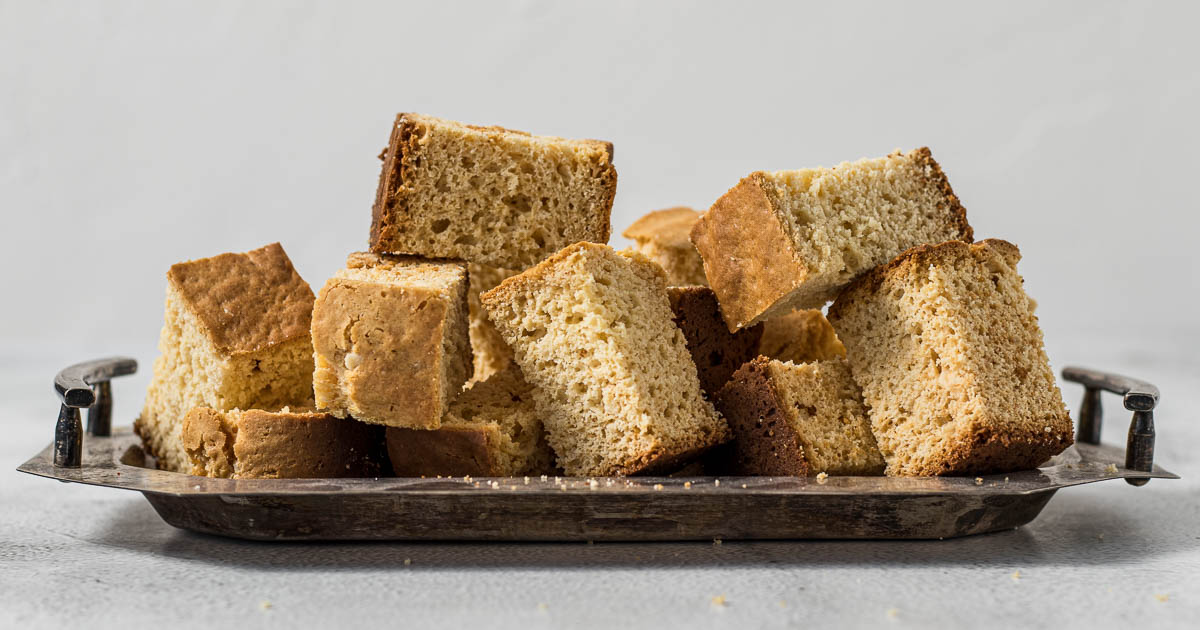
Pro Tips for this Recipe
Ovens
The temperatures stated are for conventional ovens. For convection, fan-forced, fan-assisted, or air-fryers, the temperature must be reduced by 20°C/25°F.
For baking, make sure the oven is fully preheated, and that the rack is in the middle of the oven. Open the oven as little as possible. For best baking results use an oven thermometer.
Remember that all ovens work slightly differently and bake times may need to be adjusted for your specific oven.
Bakeware
Metal bakeware is superior when it comes to baking biscuits, cookies, brownies, muffins and quick bread, scones, cakes. These heat up and cool down faster than glassware. Glassware is heavier, heats up and cools down slower than metal and is more suited for bread puddings, pies, crisps, crumbles and cobblers.
Storage and Freezing
These rusks can be kept at room temperature in an airtight container or biscuit tin for a month because the moisture has been driven off the biscuits.
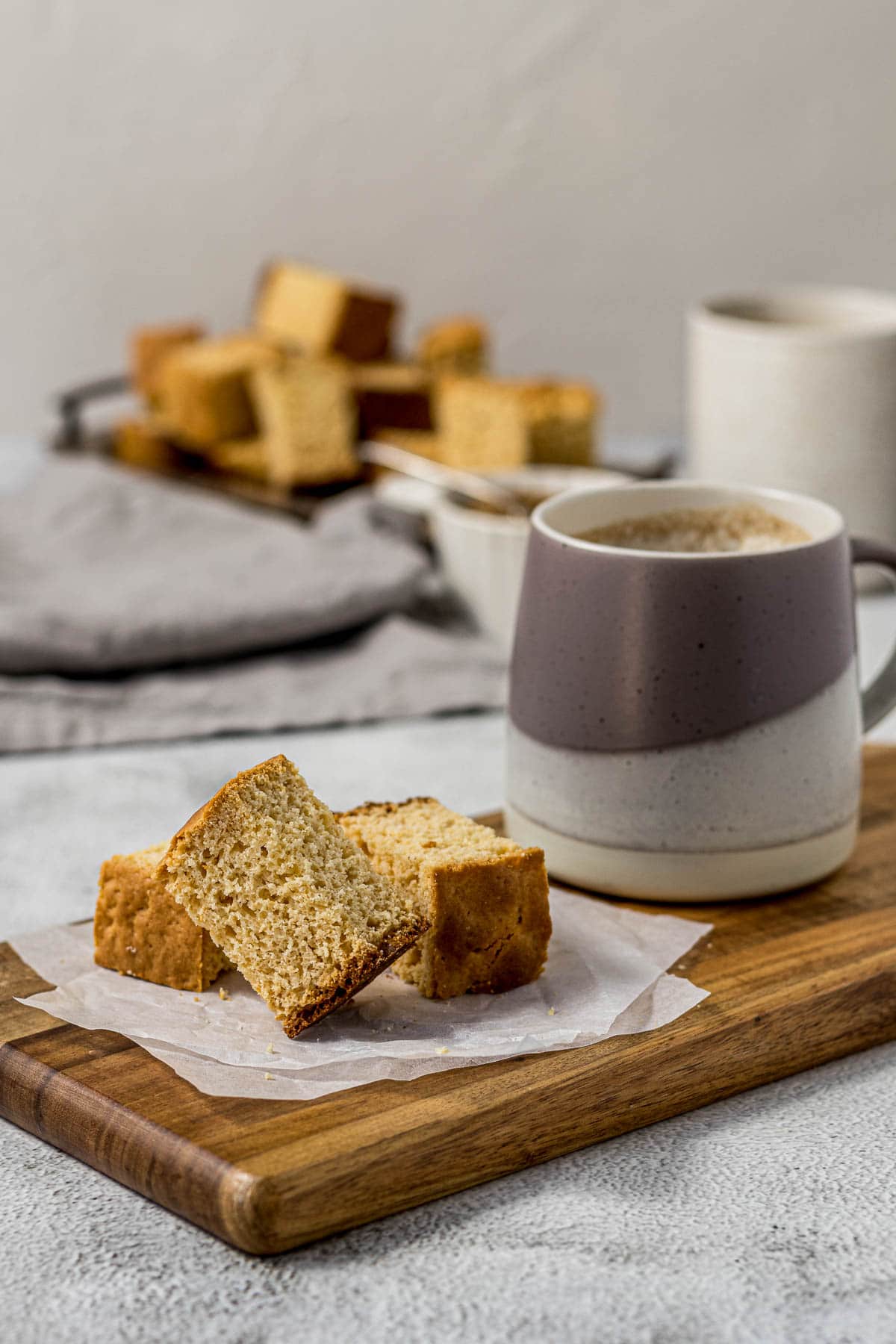
Rate & Review!
If you made this recipe, please leave a star rating! It gives my readers and me helpful feedback. If you want more recipes, subscribe to my newsletter, and follow me on Instagram, Pinterest, and Facebook!
Recipe Card
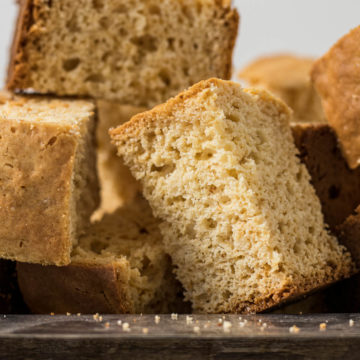
Condensed Milk Rusks
Equipment
- 9x9 Inch (23x23cm) Square Cake Pan
Ingredients
- 500 grams self-raising flour
- ½ teaspoon table salt
- ½ teaspoon baking soda (bicarb/bread soda)
- 65 grams white granulated sugar (caster/granulated)
- 125 grams butter
- 125 grams milk
- 1 egg (large - no. 7)
- 395 grams sweetened condensed milk (14oz - 1 tin)
Instructions
- Preheat the oven to 200°C/390F, or 180°C fan. Grease and line a 9"x9" (23cmx23cm) square tin.
- Weigh out the flour, and add in the salt and baking soda. Whisk through to remove any lumps and distribute the ingredients through the flour.500 grams self-raising flour, ½ teaspoon table salt, ½ teaspoon baking soda
- Melt the butter, then add in the sugar and whisk through until completely dissolved. The sugar may need to be heated with the butter to completely dissolve.65 grams white granulated sugar, 125 grams butter
- Whisk together the egg and milk. Add the milk, butter, and sweetened condensed milk to the flour. Mix with a wooden spoon until a soft dough has formed. Knead the dough a few times in the bowl, or really mix a few times after all the ingredients are combined with the wooden spoon to allow for some gluten formation.125 grams milk, 1 egg, 395 grams sweetened condensed milk
- Press the dough into the prepared baking dish.
- Bake the rusks for 45 to 60 minutes or until a cake tester comes our clean from the centre of the rusks. The rusks will have doubled in size during the baking process.
- Allow the rusk to cool for 10-15 minutes before turning it out onto a wire cooling rack to cool completely. Once completely cooled, slice the rusks using a serrated knife. Place the rusks on a baking sheet, in a single layer, and set your oven to a maximum of 110°C/230F (cool oven), preferably with the fan on to dry the rusks out. This process can take anywhere from 3 to 6 hours, usually dependent on the thickness of your rusks.
- When the rusks are dry, store them in an airtight container, at room temperature, for up to a month. Serve with a hot cup or tea or coffee for dunking.
Notes
- Placing a bit of oil on your hands will stop the dough from sticking.
- If the rusks are browning too quickly in the oven when checking them at the halfway mark, cover them with foil for the rest of the bake.
- To make condensed milk rusks without self-raising/self-rising flour, simply add 3.5 level teaspoons of baking powder to the flour.
- For a half batch of this recipe I used a full egg.
Storage and Freezing
These rusks can be kept at room temperature in an airtight container or biscuit tin for a month because the moisture has been driven off the biscuits.Nutrition
Nutrition information is an estimate. If scaling the recipe remember to scale your cook and bakeware accordingly. All temperatures stated are conventional, unless otherwise stated. Recipes tested in grams and at sea level.

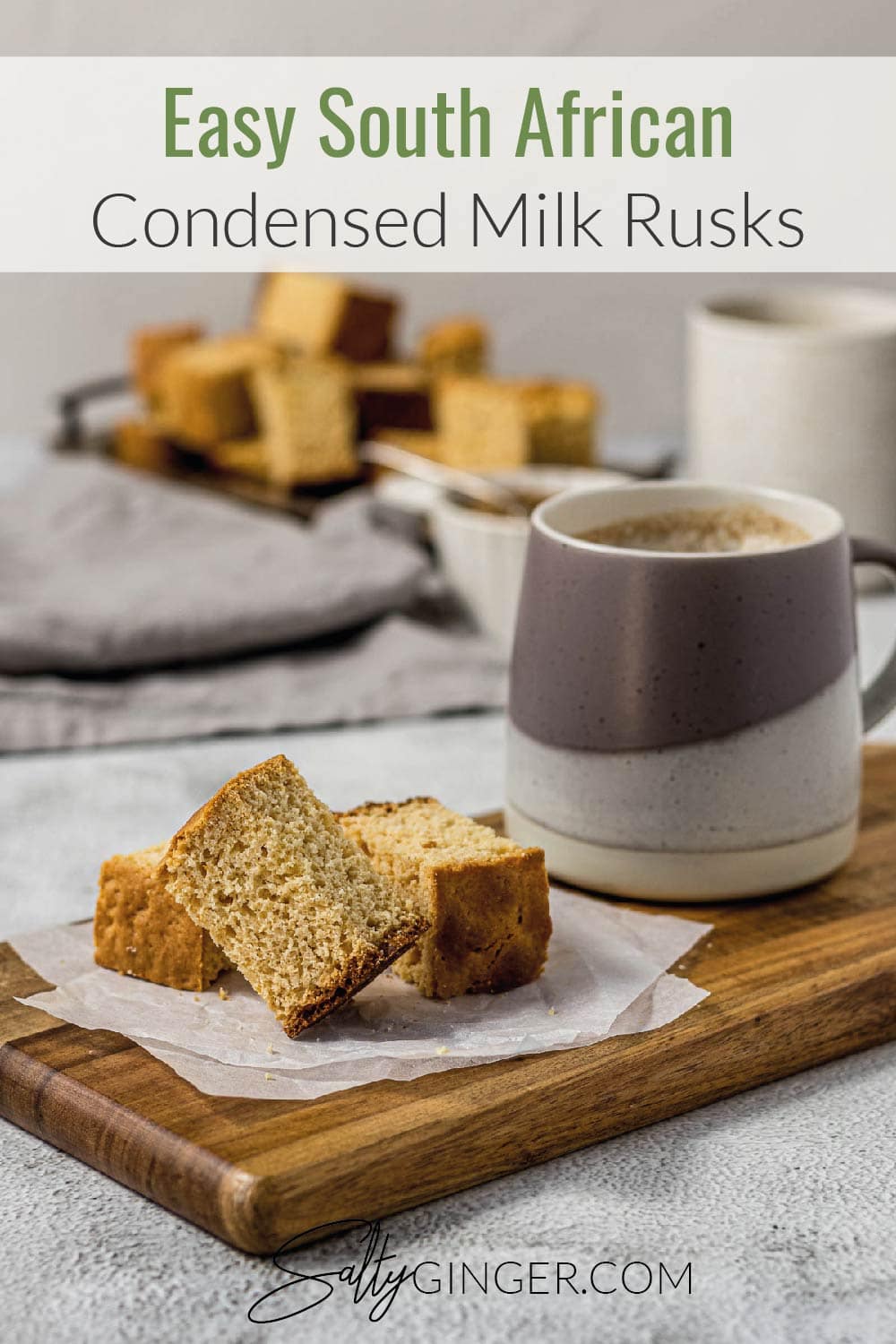
Manda says
I made your rusk recipe today! It turned out very nice. Next time, can I leave the sugar out you think? As the condensed milk is already sweetened. Thank always use someone else’s buttermilk rusks recipe, but will definitely use yours next time.
I live in the U.K..
Mary-Lou says
Hi Manda,
Thank you! I did try making these rusks with no sugar and only condensed milk but did not like the outcome. When I was testing this recipe, my goal was a sweet but not overly sweet rusk - which I think I nailed. And did try to keep the sugar to a minimum.
But feel free to experiment. If I was testing recipes for less sugar, I would do a half batch with sugar, and another half batch with about half of sugar to test the outcome. Remember there is a nifty 0.5 button on the card to make this all fairly easy!
Regards,
Mary-Lou
Maurizia Knox says
Very well organised receipy. Lovebthe way you can convert from metric to imperial.So much easier! Wish all receipts were done like this!
Live this.
Mary-Lou says
Thank you so much!
Corrie von Kotze says
Early days... rusks are baking as I write.
Only variation is I used a medium egg. The texture was far too wet to kneed. It poured into the baking tray. So we will see how it comes out.
Mary-Lou says
Hi,
Quick question - did you use 500 grams or 500 mL of flour? I'm just asking because the dough, when I make it, is not pourable (as can be seen by my photos).
Thanks
Kaylin says
Made these delicious Condensed milk rusks today, but converted the recipe to gluten-free (since my whole family is gluten intolerant).
They've turned out absolutely wonderfully and are super tasty. Not too sweet, so I can eat a couple with one cup of coffee.
The recipe is also really easy to follow for great results (I don't have huge amounts of experience making rusks). Will definitely be making them again soon.
Mary-Lou says
That's amazing! I'm assuming you are using an all-purpose GF flour? I wouldn't have thought this would work with a GF flour - but now I'm going to have to give it a go myself!
Thank you for your feedback!
Kaylin says
Yes, I used a gluten-free all purpose flour blend that is a combination of brown rice, white rice & tapioca starch. And 2 teaspoons of Xanthan Gum.
Mary-Lou says
Thank you so much for letting me know, a GF bake is on my cards.
Kaylin says
If I added seeds and/or nuts to this recipe, would it interfere with any of the ingredients or the cooking time, do you think? Absolutely cannot wait to try this recipe.
Mary-Lou Watkins says
Hi, I don't think seeds or nuts would interfere at all. So go for it!
Mo says
Gorgeous Rusks. Easy. Flop proof. Huge hit in this household. Thanks !
Marga says
Just wanted to say a BIG thank you for thinking this through in terms of being able to jump straight to the recipe, but even better, updating the ingredients/measurements based on quantity!
Lovely recipe - have used it a few times now and they came out great 👍
Nikiwe says
Hi i want the recipe of condence milk rusks
Mary-Lou Watkins says
You came to the right place! The recipe is above the comments.
Marnus says
Hi. We made these but there is no sweetness to them. Tastes a bit like dry bread. Followed the recipes to the last gram. Please help. Need condensed milk rusks.
Mary-Lou Watkins says
Hi.
This recipe already contains 65 grams sugar or 1/3 cup in addition to the sweetened condensed milk. However, if you want a sweeter rusk then you will need to add even more sugar. My buttermilk rusks contain a total of 165 grams (just over 3/4 cup) of sugar for the same size batch but this doesn't take into account the condensed milk. So personally, I would only increase the sugar to a total of 2/3 of a cup or 135 grams.